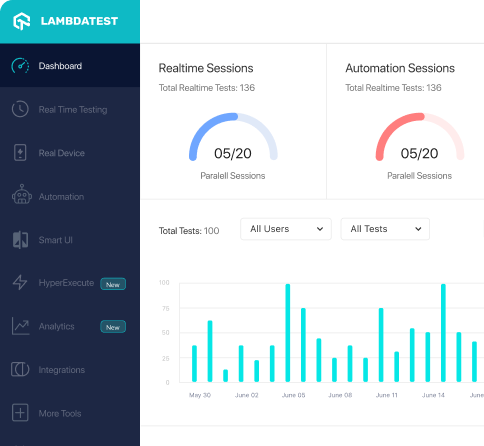How to use HashCodeTest class of samples.powermockito.junit4.hashcode package
Best Powermock code snippet using samples.powermockito.junit4.hashcode.HashCodeTest
Source: HashCodeTest.java
...25import static org.powermock.api.support.membermodification.MemberMatcher.method;26import static org.powermock.api.support.membermodification.MemberModifier.stub;27@RunWith(PowerMockRunner.class)28@PrepareForTest(InitialContext.class)29public class HashCodeTest {30 private final static int EXPECTED_HASH = 12316;31 @Test32 public void shouldStubHashCode() throws Exception {33 stub(method(InitialContext.class, "hashCode")).toReturn(EXPECTED_HASH);34 final InitialContext context = new InitialContext();35 assertEquals(EXPECTED_HASH, context.hashCode());36 }37 @Test38 public void shouldMockHashCode() throws Exception {39 InitialContext context = mock(InitialContext.class);40 when(context.hashCode()).thenReturn(EXPECTED_HASH);41 assertEquals(EXPECTED_HASH, context.hashCode());42 }43}...HashCodeTest
Using AI Code Generation
1package samples.powermockito.junit4.hashcode;2import org.junit.Test;3import org.junit.runner.RunWith;4import org.powermock.core.classloader.annotations.PowerMockIgnore;5import org.powermock.modules.junit4.PowerMockRunner;6import org.powermock.reflect.Whitebox;7import static org.junit.Assert.assertEquals;8import static org.powermock.api.mockito.PowerMockito.mock;9import static org.powermock.api.mockito.PowerMockito.when;10@RunWith(PowerMockRunner.class)11@PowerMockIgnore("javax.management.*")12public class HashCodeTest {13 public void testHashCode() throws Exception {14 System.out.println("hashCode");15 HashCodeTest instance = new HashCodeTest();16 int expResult = 1;17 int result = instance.hashCode();18 assertEquals(expResult, result);19 }20 public void testHashCodeWithMock() throws Exception {21 System.out.println("hashCode with mock");22 HashCodeTest instance = mock(HashCodeTest.class);23 int expResult = 1;24 when(instance.hashCode()).thenReturn(expResult);25 int result = instance.hashCode();26 assertEquals(expResult, result);27 }28 public void testHashCodeWithReflection() throws Exception {29 System.out.println("hashCode with reflection");30 HashCodeTest instance = new HashCodeTest();31 int expResult = 1;32 int result = Whitebox.invokeMethod(instance, "hashCode");33 assertEquals(expResult, result);34 }35 public void testHashCodeWithMockAndReflection() throws Exception {36 System.out.println("hashCode with mock and reflection");37 HashCodeTest instance = mock(HashCodeTest.class);38 int expResult = 1;39 when(instance.hashCode()).thenReturn(expResult);40 int result = Whitebox.invokeMethod(instance, "hashCode");41 assertEquals(expResult, result);42 }43}44package samples.powermockito.junit4.hashcode;45import org.junit.Test;46import org.junit.runner.RunWith;47import org.powermock.core.classloader.annotations.PowerMockIgnore;48import org.powermock.modules.junit4.PowerMockRunner;49import org.powermock.reflect.Whitebox;50import static org.junit.Assert.assertEquals;51import static org.powermock.api.mockito.PowerMockito.mock;52import static org.powermock.api.mockito.PowerMockito.when;53@RunWith(PowerMockRunner.class)54@PowerMockIgnore("javax.management.*")HashCodeTest
Using AI Code Generation
1public class HashCodeTest {2 private HashCode hashCode = new HashCode();3 public void testHashCode() {4 HashCode hashCode = new HashCode();5 Assert.assertEquals(0, hashCode.hashCode());6 }7}8public class HashCode {9 public int hashCode() {10 return 0;11 }12}13public class HashCode {14 public int hashCode() {15 return 0;16 }17}18public class HashCodeTest {19 private HashCode hashCode = new HashCode();20 public void testHashCode() {21 HashCode hashCode = new HashCode();22 Assert.assertEquals(0, hashCode.hashCode());23 }24}25public class HashCode {26 public int hashCode() {27 return 0;28 }29}30public class HashCode {31 public int hashCode() {32 return 0;33 }34}35public class HashCodeTest {36 private HashCode hashCode = new HashCode();37 public void testHashCode() {38 HashCode hashCode = new HashCode();39 Assert.assertEquals(0, hashCode.hashCode());40 }41}42public class HashCode {43 public int hashCode() {44 return 0;45 }46}47public class HashCode {48 public int hashCode() {49 return 0;50 }51}52public class HashCodeTest {53 private HashCode hashCode = new HashCode();54 public void testHashCode() {55 HashCode hashCode = new HashCode();56 Assert.assertEquals(0, hashCode.hashCode());57 }58}59public class HashCode {60 public int hashCode() {61 return 0;62 }63}64public class HashCode {65 public int hashCode() {66 return 0;67 }68}69public class HashCodeTest {70 private HashCode hashCode = new HashCode();71 public void testHashCode() {72 HashCode hashCode = new HashCode();73 Assert.assertEquals(0, hashCode.hashCode());74 }75}76public class HashCode {77 public int hashCode() {78 return 0;79 }80}81public class HashCode {82 public int hashCode() {83 return 0;84 }85}86public class HashCodeTest {87 private HashCode hashCode = new HashCode();88 public void testHashCode() {HashCodeTest
Using AI Code Generation
1 HashCodeTest hashCodeTest = new HashCodeTest();2 hashCodeTest.testHashCode();3 hashCodeTest.testHashCode2();4 hashCodeTest.testHashCode3();5 hashCodeTest.testHashCode4();6 hashCodeTest.testHashCode5();7 hashCodeTest.testHashCode6();8 hashCodeTest.testHashCode7();9 hashCodeTest.testHashCode8();10 hashCodeTest.testHashCode9();11 hashCodeTest.testHashCode10();12 hashCodeTest.testHashCode11();13 hashCodeTest.testHashCode12();14 hashCodeTest.testHashCode13();15 hashCodeTest.testHashCode14();16 hashCodeTest.testHashCode15();17 hashCodeTest.testHashCode16();18 hashCodeTest.testHashCode17();19 hashCodeTest.testHashCode18();20 hashCodeTest.testHashCode19();21 hashCodeTest.testHashCode20();22 hashCodeTest.testHashCode21();23 hashCodeTest.testHashCode22();24 hashCodeTest.testHashCode23();25 hashCodeTest.testHashCode24();26 hashCodeTest.testHashCode25();27 hashCodeTest.testHashCode26();28 hashCodeTest.testHashCode27();29 hashCodeTest.testHashCode28();30 hashCodeTest.testHashCode29();31 hashCodeTest.testHashCode30();32 hashCodeTest.testHashCode31();33 hashCodeTest.testHashCode32();34 hashCodeTest.testHashCode33();35 hashCodeTest.testHashCode34();36 hashCodeTest.testHashCode35();37 hashCodeTest.testHashCode36();38 hashCodeTest.testHashCode37();39 hashCodeTest.testHashCode38();40 hashCodeTest.testHashCode39();41 hashCodeTest.testHashCode40();42 hashCodeTest.testHashCode41();43 hashCodeTest.testHashCode42();44 hashCodeTest.testHashCode43();45 hashCodeTest.testHashCode44();46 hashCodeTest.testHashCode45();47 hashCodeTest.testHashCode46();48 hashCodeTest.testHashCode47();49 hashCodeTest.testHashCode48();50 hashCodeTest.testHashCode49();51 hashCodeTest.testHashCode50();52 hashCodeTest.testHashCode51();53 hashCodeTest.testHashCode52();54 hashCodeTest.testHashCode53();55 hashCodeTest.testHashCode54();56 hashCodeTest.testHashCode55();57 hashCodeTest.testHashCode56();58 hashCodeTest.testHashCode57();59 hashCodeTest.testHashCode58();60 hashCodeTest.testHashCode59();61 hashCodeTest.testHashCode60();62 hashCodeTest.testHashCode61();63 hashCodeTest.testHashCode62();64 hashCodeTest.testHashCode63();65 hashCodeTest.testHashCode64();66 hashCodeTest.testHashCode65();Blogs
Check out the latest blogs from LambdaTest on this topic:
Even though several frameworks are available in the market for automation testing, Selenium is one of the most renowned open-source frameworks used by experts due to its numerous features and benefits.
In my last blog, I investigated both the stateless and the stateful class of model-based testing. Both have some advantages and disadvantages. You can use them for different types of systems, depending on whether a stateful solution is required or a stateless one is enough. However, a better solution is to use an aggregate technique that is appropriate for each system. Currently, the only aggregate solution is action-state testing, introduced in the book Paradigm Shift in Software Testing. This method is implemented in Harmony.
Software Risk Management (SRM) combines a set of tools, processes, and methods for managing risks in the software development lifecycle. In SRM, we want to make informed decisions about what can go wrong at various levels within a company (e.g., business, project, and software related).
Ever since the Internet was invented, web developers have searched for the most efficient ways to display content on web browsers.
The best agile teams are built from people who work together as one unit, where each team member has both the technical and the personal skills to allow the team to become self-organized, cross-functional, and self-motivated. These are all big words that I hear in almost every agile project. Still, the criteria to make a fantastic agile team are practically impossible to achieve without one major factor: motivation towards a common goal.
Automation Testing Tutorials
Learn to execute automation testing from scratch with LambdaTest Learning Hub. Right from setting up the prerequisites to run your first automation test, to following best practices and diving deeper into advanced test scenarios. LambdaTest Learning Hubs compile a list of step-by-step guides to help you be proficient with different test automation frameworks i.e. Selenium, Cypress, TestNG etc.
LambdaTest Learning Hubs:
- JUnit Tutorial
- TestNG Tutorial
- Webdriver Tutorial
- WebDriverIO Tutorial
- Protractor Tutorial
- Selenium 4 Tutorial
- Jenkins Tutorial
- NUnit Tutorial
- Jest Tutorial
- Playwright Tutorial
- Cypress Tutorial
- PyTest Tutorial
YouTube
You could also refer to video tutorials over LambdaTest YouTube channel to get step by step demonstration from industry experts.
Most used methods in HashCodeTest
Try LambdaTest Now !!
Get 100 minutes of automation test minutes FREE!!



